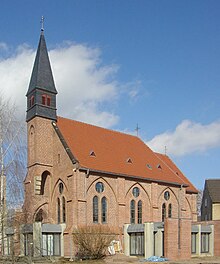Immaculate Conception (Lutherstadt Wittenberg)
The Immaculate Conception Church is a Roman Catholic church in Lutherstadt Wittenberg . It is the parish church of the parish “St. Marien, Wittenberg ”, to which several parishes in the area belong since 2010.
history
After the Reformation there were no more Catholics in Wittenberg. From around 1820/1830 Catholics came back to the city through the Prussian military. In 1858 the parish, to which 70 dragoons and 170 civilians belonged, got its first pastor. She bought what is now the rectory and set up a Catholic school in it. She also bought the neighboring property to build a church. The property on Mauerstraße was between clothmaking workshops on the edge of the old town. A “more prominent” location for a Catholic church in the city of the Reformation did not seem appropriate to the Wittenberg magistrate .
The church was built in 1868/1869 according to plans by the Paderborn architect Arnold Güldenpfennig . Only after three years of use was it consecrated by Bishop Konrad Martin in 1872 , as the Paderborn bishop only traveled to the central German part of his district, the Magdeburg Episcopal Commissariat , at longer intervals. The municipality was part of the diocese of Paderborn (1930 Archdiocese) from 1973 to 1994 for the Episcopal Office Magdeburg , which for 1994 Roman Catholic Diocese of Magdeburg was charged.
In 1908 the previous "mission office" was raised to a parish .
A large influx of Catholics took place between 1945 and 1947. At that time, the community had up to 20,000 members at times, mainly displaced persons and refugees , most of whom moved on to the west. Today the congregation has about 2000 members; in Wittenberg, around 80 percent of the population describe themselves as non-Christians.
architecture
It is a neo-Gothic hall church made of brick with a rectangular choir and a roof turret over the portal gable. The interior is divided by two columns in the central axis.
St. Marien was renovated in 1999/2000 under the direction of the architect Gerold A. Ringelhan .
Furnishing
The Gothic carved altar, laid out as a triptych , came into the church in 1975. The middle field shows Mary (mother of Jesus) with the baby Jesus, surrounded by angels making music. In the corners there are four representations of Marian symbols , three biblical and one taken from ancient mythology , which stand for the Immaculate Conception and the meaning of Mary's salvation: top left the burning bush ( Ex 3.2 EU ), top right the Porta clausa ( the locked gate) of the prophet Ezekiel , below left Augustus and the Tiburtine Sibyl , below right the fleece of Gideon ( Ri 6,36-40 EU ).
The ambo and altar were made by the Kronach sculptor Heinrich Schreiber (consecrated on June 12, 2000), as was the Edith Stein tablet. Günter Grohs from Wernigerode designed the windows .
Church life
Today the community belongs to the diocese of Magdeburg . As a result of the structural reform of the diocese, the parishes in Annaburg , Jessen , Bad Schmiedeberg , Elster , Kemberg , Piesteritz , Wittenberg and Zahna have formed a joint parish of St. Marien, Wittenberg , whose central parish church is the Immaculate Conception Church . Confusion of names with the historical city and parish church of St. Mary , which has been Protestant since the Reformation , is ruled out because it is officially called Stadtkirche Wittenberg . The Catholic community runs a day-care center with 44 places.
Since 1935 there has been a branch of the Schoenstatt Sisters of Mary in Wittenberg , who are active in pastoral care and in the hospital of the Alexians ("Klinik Bosse").
The relationship with the Protestant communities in the city is shaped by numerous encounters and joint celebrations throughout the year. The cross on the Apollensberg in the Wittenberg district of Apollensdorf is supposed to be a sign of community.
Web links
Individual evidence
- ↑ Church historian Volker Leppin hopes for bridges between the denominations ( Memento from February 6, 2013 in the web archive archive.today )
- ^ City parish Wittenberg
Coordinates: 51 ° 52 ′ 6.9 " N , 12 ° 38 ′ 42.3" E


